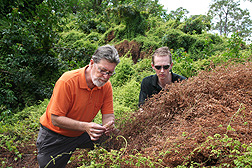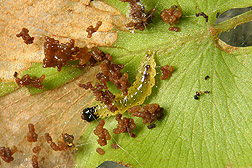Tiny Moth Tackles Old World Climbing Fern
|
|
For more than 12 years, ARS scientists and cooperators have been on a quest to control Old World climbing fern, one of the most invasive plants in all of Florida and a large threat to the prized Florida Everglades.
The fern, Lygodium microphyllum, can reach lengths of over 90 feet. It forms thick blankets of light-green vegetation that can completely cover other plants, blocking sunlight crucial to their survival. Lygodium also allows wildfires that would normally only scar cypress tree trunks to race up the tree and set the canopy afire.
If left uncontrolled, this aggressive invader could soon cover one-third of south Florida and cost $8 million annually in control expenses.
ARS entomologists Bob Pemberton and Anthony Boughton, with the Invasive Plant Research Laboratory in Fort Lauderdale, Florida, have been working closely with scientists from the Brisbane-based ARS Australian Biological Control Laboratory—a cooperative venture with Australia’s Commonwealth Scientific and Industrial Research Organization, or CSIRO—to find natural enemies that will stop climbing fern’s spread. Additional cooperators include the South Florida Water Management District, the Florida Fish and Wildlife Conservation Commission, and the Florida Department of Environmental Protection’s Division of Recreation and Parks.
Now, they may have found a solution.
|
|
Small Insect, Big Job
A little moth known as Neomusotima conspurcatalis—nicknamed “Neo”—is currently the most successful of all the biocontrol agents that have been tested by the Fort Lauderdale and Brisbane scientists.
“Since its initial release in January 2008, Neo has rapidly expanded its populations,” says Pemberton. “There are hundreds of thousands of moths.”
Pemberton was the first to discover the biocontrol potential of Neomusotima insects. He found insects of this genus feeding on L. microphyllum near Hong Kong during a 1997 expedition. Later work by Brisbane scientists Matt Purcell, Tony Wright, former Brisbane director John Goolsby—now with ARS at Weslaco, Texas—and John Molden of the Department of Agriculture and Food, Western Australia, highlighted Neo’s potential. Rigorous testing by both labs led to Neo’s 2008 outdoor release in Florida.
Despite its small size, Neo is formidable. The moth reproduces quickly, generating large numbers of offspring almost every month. Neo’s larvae feed on Lygodium leaves and, in large numbers, can defoliate entire plants. The larvae also eat the later regrowth.
Today, Neo’s thriving colonies—direct descendants of the insects imported from Australia—prosper at three test sites in Florida’s Jonathan Dickinson State Park. Neo has browned and defoliated Lygodium at all three sites, according to Boughton, and is now expanding to adjacent Lygodium-infested areas in the park.
“Neo’s impact is incredible,” says Fort Lauderdale research leader Ted Center. “The involvement of the Australian lab was critical and shows the advantage of having ARS foreign labs.”
The push continues to find new insects—moths, mites, beetles, and more—to help hardworking Neo.
Why the need for more recruits?
Explains Pemberton, “Using a diverse array of organisms—some feeding on the same parts of the fern and others feeding on different portions—provides a better attack on this weed.”
Stem Borers: Deadly Insiders
One of the most promising of the insects that might someday join the fern-fighting force in Florida is a small brown moth known as a “stem borer.” As its name implies, this biocontrol’s bailiwick is the elongated stems of climbing fern that extend upright from the plant’s dense, ground-hugging mats.
The female moth, which measures about a half-inch from wingtip to wingtip, lays eggs that hatch into unusually long, skinny, cream-colored larvae, explains entomologist Purcell, who is acting director at the Australian lab.
The larvae bore into the fern’s stems and, by eating the stem innards, or pith, create a snug home for themselves.
“This can be catastrophic for the plant,” says Purcell. “The stem borer’s tunneling and feeding can kill all of the fern’s growth above the larva’s entry point. That means, essentially, that a half-inch-long larva that bores a tunnel a few feet long has the potential to kill 40 feet or more of fern. That’s a remarkably powerful punch for so small an insect.”
Pioneering research by the Brisbane scientists pinpointed stem borers as potential biocontrols in 1999. Later expeditions taken by Purcell; CSIRO colleagues Tony Wright, Jeff Makinson, Bradley Brown, and Ryan Zonneveld; and former Brisbane director Goolsby encompassed Australia, Singapore, Thailand, Indonesia, Malaysia, and Hong Kong and other parts of China. These fern forays have yielded stem borers from several different species of Lygodium.
Preliminary determinations by M. Alma Solis, an expert on fern-feeding moths and research leader of the ARS Systematic Entomology Laboratory in Beltsville, Maryland, indicate that borers collected in Hong Kong, Singapore, and Thailand are actually new to science.
Notes Purcell, “We’re the most excited about the stem borer from Hong Kong because we’ve been able to raise it successfully in captivity in cages of potted Lygodium microphyllum plants.”
That hasn’t been the case, for instance, with the Singapore stem borer specimens. “They like thicker-stemmed plants which, at present, can’t be provided for them in the lab,” Purcell says. “That makes rearing the Singapore borers near impossible, for now.”
Robust laboratory colonies are a must. They’re essential for the “host-specificity tests” in which scientists determine whether stem borers can survive and reproduce on climbing fern exclusively, instead of being able to prosper on other plants—such as Florida’s many native ferns. And bustling lab colonies are of course needed to stock fern-infested Florida sites and to replenish those outdoor colonies until they become self-sustaining.
With further research and requisite federal and state approvals, stem borers may one day work in harmony with Neo to halt climbing fern’s advance. Their prospective new home, Florida’s fragile Everglades ecosystem, is an irreplaceable national treasure. If they help save the ’Glades, these insects will surely become a national treasure, too.—By Stephanie Yao and Marcia Wood, Agricultural Research Service Information Staff.
This research is part of Crop Protection and Quarantine, an ARS national program (#304) described on the World Wide Web at www.nps.ars.usda.gov.
To reach scientists mentioned in this article, contact Stephanie Yao, USDA-ARS Information Staff, 5601 Sunnyside Ave., Beltsville, MD 20705-5129; phone (301) 504-1619, fax (301) 504-1486.
"Tiny Moth Tackles Old World Climbing Fern" was published in the July 2009 issue of Agricultural Research magazine.








